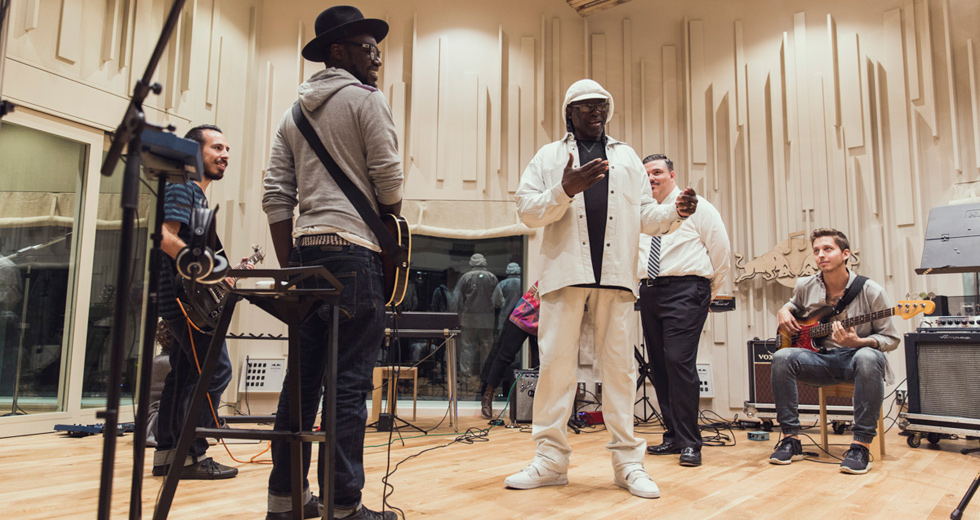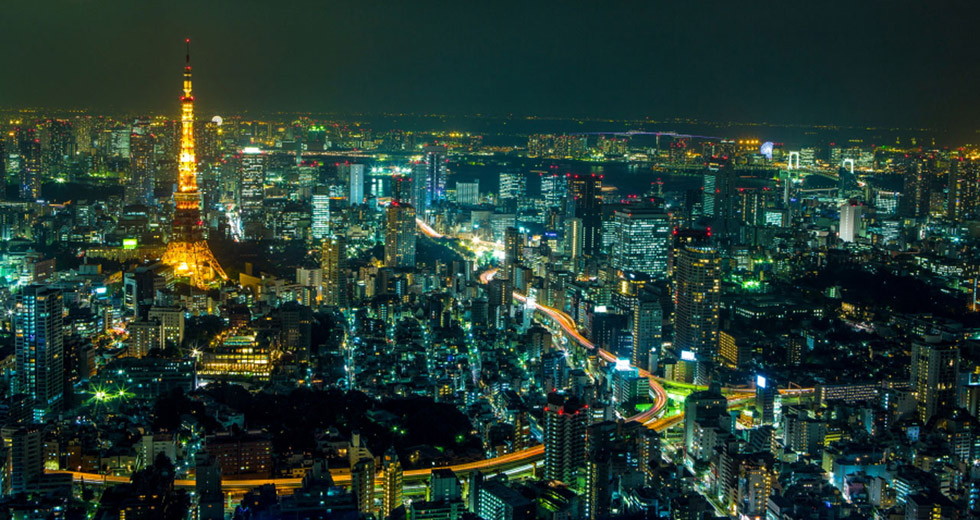Yellow Magic Orchestra: The Pre-MIDI Technology Behind Their Anthems
It was the late ’70s when the Yellow Magic Orchestra came together and completed two successful world tours – an era when companies like Honda and Sony had established dominance in global markets and books such as Japan as Number One: Lessons for America by Ezra Vogel were being published. Shortly after, Japanese synthesizer makers such as Yamaha, Roland, and Korg made their global debut and quickly unseated industry pioneers like Moog and Arp. But it was only a few later that the MIDI connection format was established by Roland. By the time Yamaha, Roland, Korg, Sequential Circuits, and Oberheim collaborated to start the MIDI project, YMO had already made some of their most famous albums.
At their world tour in ‘79, the stage was graced by the likes of the Moog III-C, Polymoog, Arp Odyssey, and Oberheim 8 Voice, all quite expensive foreign instruments. This mass of equipment was similar to a Joe Zawinul setup, and had press at the countries where they toured comparing YMO to Weather Report. This was not far from the truth, as YMO were active in an era where foreign instruments such as Moog and Arp played lead roles in the studios while Japanese synthesizers were still looked down upon. Indeed, it was the accomplishments of YMO as a synthesizer orchestra worldwide that spurred development among domestic companies, leading to the birth of later domestic models which became standards of electronic music worldwide.
The centerpiece of early YMO sets was a giant modular synthesizer, the Moog III-C; affectionately known to people in the scene back then as the “dresser.” It was the personal possession of the “fourth member” of YMO, engineer and programmer while on tour, Hideki Matsutake. He began his career as an assistant to Isao Tomita, and became a programmer at the dawning of electronic music in Japan. Matsutake synthesized music for TV commercials as well as doing electronic cover albums of the Beatles and various oldies before linking with the band. The first time Matsutake was called on was for the second recording session of the debut single, “Firecracker” (later included in the album Yellow Magic Orchestra). The first recording session, which Matsutake was not a part of, was said to have been done without the use of a computer but instead with an Arp Solina in a fusion style.
YMO didn’t think to use a computer in the beginning because Haruomi Hosono, Yukihiro Takahashi, and Ryuichi Sakamoto were all highly skilled players. In 1977, when Hosono had begun to formulate the idea for a new disco instrumental group, he first approached Tatsuo Hayashi of Tin Pan Alley and Hiroshi Sato of Huckle Buck, players active in the fusion genre at the time. However, when these invitations were turned down, Hosono called on two players who were still relatively unknown, Yukihiro Takahashi and Ryuichi Sakamoto. In an era when the majority of drummers refused to play while keeping time to the clicks from a rhythm box, Takahashi’s boundless curiosity enabled him to session with enthusiasm. Sakamoto, meanwhile, was an arranger who had finished graduate school at Tokyo University of the Arts, and was in the process of recording a solo project, A Thousand Knives, which was being created on the then brand new Roland MC-8.
The Roland MC-8 was the world’s first ten key input digital sequencer. It was an invention of a bygone era which quantified note information (a quarter note = 48) and inputs were punched in via a calculator type keypad. The reason why Sakamoto had no qualms about computer recordings was that he studied and experimented with the works of Iannis Xenakis, among others, while at university. Sakamoto probably was the only session musician that Hosono knew who had a thorough knowledge of computers at the time that was able to apply that knowledge to popular music.
The spark which led to Hosono’s use of a computer during the second recording of “Firecracker” was his discovery of Kraftwerk. Hosono was drawn to the German group’s method of recreating a perfected groove, expressed through a machine, which eliminated the subtle variations in timing that occurs when an instrument is performed by a human being. Matsutake was incorporated as a programmer due to his involvement in Sakamoto’s solo project. The swingy funk element present throughout their first album Yellow Magic Orchestra was expressed by programming through subtle variations of the input (if a quarter note = “48” they used inputs such as “45” and “47” to produce swing).
One reason Hosono wanted to create an instrumental group was that it got around the language barrier. He saw Kraftwerk and Giorgio Moroder’s ability to use computer created music to overcome the handicaps that prevented most foreign acts from being able to make it in America. Luck was also on their side, as shortly after their debut they received a call from A&M Records about releasing their record in the United States. As YMO gained traction, they were struck anew by the music of Devo, a post-punk group from Ohio. YMO quickly emulated Devo’s mutant-like sounds and synth overlays, abandoning their original philosophy of hermetically sealed computer compositions. This change in direction became YMO’s second album, Solid State Survivor.
During the incubation period, Hosono had purchased a Korg PS-3300. Much like his solo works Paraiso and Cochin Moon, early YMO recordings were created by bringing their own instruments to the studio. However, through Matsutake’s programming and the use of imported synthesizers such as Moog and Oberheim, personal instruments rarely made studio appearances after a while. The A studio at Alfa Records, which was the center of operations for YMO, became the first studio in Japan to have a 24 channel recording environment. The studio also had high-end foreign effects such as Lexicon digital reverb which were still rare at the time. Solid State Survivor was one of Japan’s first digitally mixed albums. Among the vast array of imported equipment, the only domestic piece was the Roland VP-330, which you can hear used for the robotic vocoder sounds at the beginning of “Technopolis.” (The following album, Zōshoku, included a cover of “Tighten Up” by Archie Bell & The Drells where the VP-330 was used for a vocoded doo-wop section.)
YMO began as a studio group, but they were soon asked to start performing live by A&M. This was no small undertaking. YMO were one of the first electronic bands to perform live in front of an audience. To do so, the trio recruited a few extra members, and the Moog III-C, Polymoog, Oberheim, and other pieces were rented from Matsutake’s company to take on tour. One of the most instruments they used on stage was the MC-8. One track on the sequencer was dedicated to the click sound which was routed to the artists’ headphones while the three played in harmony to the other outputs. (It is often said that crowds were amazed at the time by how the songs began without a count off, much like a punk rock band.)
Another anomaly to their performances came from the MC-8 itself. Despite being a computer with a CPU, it didn’t have a cooling fan as it was designed for use in an air-conditioned studio. In some parts of the live recordings made of the YMO tour, you can hear the MC-8 cutting out due to overheating. By the end of the tour, however, the human element of the YMO had become used to these anomalies and played through the computer’s heating issues without a problem, displaying their toughness as a live act. (It’s somewhat ironic that a group that began as an experiment to eliminate the human element from the performance of music actually rose to prominence in great part through the level of skill the players themselves displayed.)
The majority of synthesizers back in the late ’70s were monophonic, didn’t have memory functions, and required much time and effort to set parameters. The first polyphonic synthesizer that made the selection of presets on the fly possible was the Prophet 5 by Sequential Circuits which came out in 1977. With the appearance of this user-friendly synthesizer, the way YMO made music changed exponentially. At the beginning of 1981 – after they returned from their second world tour – the recording of BGM started in earnest. Despite Sakamoto’s boycott of the recording, Hosono and Takahashi were able to learn how to operate the synthesizers themselves, and created most of the sounds for the BGM album using the Prophet 5.
Another piece of equipment that began to make an appearance in YMO’s recordings was the Roland TR-808. It was used for the first time on “1000 Knives” at the final stop of the 1980 world tour in the Tokyo Budokan, and quickly took on an important role in the BGM rhythm section. The MC-4 sequencer – also created by Roland in 1980 – pioneered a keyboard input which enabled Hosono to do his own programming for albums including and after Uwakina Bokura.
Amidst the YMO boom, the “fourth member” of the group, Hideki Matsutake began to receive recognition and began his own group, Logic System, in 1980. The solemn European synphonics of his first album were created on the E-mu module. (It was introduced at the second YMO world tour for the blaring noises in the introduction to “Riot in Lagos.”) On Logic System’s second album, Matsutake incorporated sounds from the first digital drum, the LM-1. The world’s first production PCM rhythm machine, it sampled drum sounds onto the ROM and patterns could then be programmed and played in sequence, reproducing a sound similar to live drums.
Although Roger Nichols created and used a prototype similar to the LM-1 for Steely Dan’s Gaucho in 1980, the LM-1 was the first production model of its kind. After returning to Japan, Matsutake requested engineers purchase the LM-1 for use at the studio, as it was too expensive for him to afford. As a result, the made-to-order version of the LM-1 sampler, the LMD-649, is used in both YMO’s Technodelic and Logic System’s Touhokaisha. On Technodelic, you can hear the results of YMO sampling many different sounds, like banging on large cans, drills boring in a factory, and gamelans.
With the release of two monumental albums in 1981, BGM (March) and Technodelic (November), YMO went on a well-deserved hiatus the following year. The members relaxed, and each worked on solo projects. Ryuichi Sakamoto did the soundtrack for Merry Christmas, Mr. Lawrence, Haruomi Hosono released Philharmony and Yukihiro Takahashi released Boku Daijyoubu, all of which received high praise. With improvements in music technology, each member could create an album on their own with a YMO sound.
Nonetheless, the group came back together in 1983 and produced Uwakina Bokura and Service, which primarily used the LM-1, E-mulator, and Prophet 5. The recording didn’t require a specialized engineer, and Hideki Matsutake was not present during the production of the albums. Their edgy New Wave sound was a thing of the past, replaced by a lounge-y pop sound. After the completion of a tour focusing on the latter works for domestic fans, YMO entered a phase of prolonged silence.
In 1984, Yamaha released the world’s first MIDI compatible DX-7 digital synthesizer. It was received with an outpouring of joy from the music world, and in its wake, the quality, quantity, and economy of synthesizers changed dramatically. Everybody from the top musicians in New York to folk musicians in Africa were creating music on the DX-7, ushering in an age of technological equality. Before that, though, groups like YMO pushed the boundaries of available technology and, in turn, inspired the companies that would go on to change the world of music.
Header image © Felipe Gabriel

